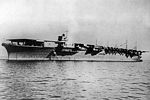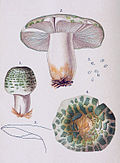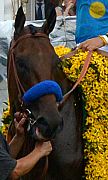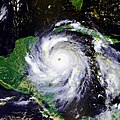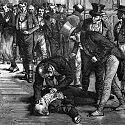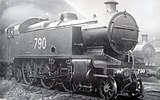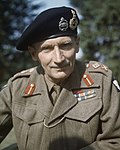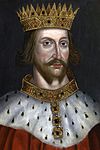| << | Today's featured articles for May 2016 | >> | ||||
|---|---|---|---|---|---|---|
| Su | Mo | Tu | We | Th | Fr | Sa |
| 1 | 2 | 3 | 4 | 5 | 6 | 7 |
| 8 | 9 | 10 | 11 | 12 | 13 | 14 |
| 15 | 16 | 17 | 18 | 19 | 20 | 21 |
| 22 | 23 | 24 | 25 | 26 | 27 | 28 |
| 29 | 30 | 31 | ||||
May 1
Blakeney Point is a National Nature Reserve near Blakeney on the north coast of Norfolk, England. It features a 6.4 km (4 mi) spit of shingle stones and sand dunes, as well as salt marshes and tidal mudflats. Land reclamation projects starting in the 17th century broadened the spit, but silted up nearby river channels. Ruins of a medieval dwelling called Blakeney Chapel and a monastery are buried in the marshes. The area has been studied for more than a century, following pioneering ecological studies by botanist Francis Wall Oliver and a bird ringing programme initiated by ornithologist Emma Turner. The reserve is important for breeding birds, especially terns, and for migrating birds in autumn. Up to 500 seals at a time gather at the end of the spit, and its sand and shingle hold specialised invertebrates and plants, including the edible samphire. The spit is moving towards the mainland at about 1 m (1 yd) per year; several former islets have been covered by the advancing shingle and then lost to the sea. Managed by the National Trust since 1912, Blakeney Point lies within an Area of Outstanding Natural Beauty and a World Biosphere Reserve. (Full article...)
May 2
The noisy miner (Manorina melanocephala) is a bird native to eastern and south-eastern Australia in the honeyeater family. It is grey with a black head, orange-yellow beak and feet, a distinctive yellow patch behind the eye and white tips on the tail feathers. Its almost constant vocalizations, particularly from young birds, include a large range of calls, scoldings and alarms. Primarily inhabiting dry, open eucalypt forests without understory shrubs, noisy miners are gregarious and territorial; they forage, bathe, roost, breed and defend territory communally, forming colonies of up to several hundred birds. Birds that live close to each other form stable associations called coteries. Temporary flocks are formed for activities such as mobbing a predator. The noisy miner is an aggressive bird, chasing, pecking, fighting, scolding, and mobbing both intruders and colony members throughout the day. The bird's numbers have increased significantly in many locations across its range, particularly in human-dominated habitats in which avian diversity has decreased. (Full article...)
May 3
The Carpet from Bagdad is a 1915 American silent adventure film directed by Colin Campbell, based on Harold MacGrath's 1911 novel of the same name. In the story, Horace Wadsworth (played by Guy Oliver), one of a gang of criminals planning a bank robbery in New York, steals a prayer rug from a Baghdad mosque. He sells the carpet to antique dealer George Jones (Wheeler Oakman) to fund the robbery scheme. The carpet's guardian kidnaps both men and Fortune Chedsoye (Kathlyn Williams), the innocent daughter of another conspirator, but they escape. Marketing for the film included a media tour of part of the set and an invitation-only screening sponsored by the publisher of MacGrath's book. The Carpet from Bagdad was released on 3 May 1915 to mostly positive reviews. Many praised the tinted desert scenes and realistic Middle East imagery, although some felt the scenery overshadowed the characters. The film is now lost, except for one badly damaged reel salvaged from the RMS Lusitania in 1982. Images from several feet of the reel were recovered by the British Film Institute's National Archive. (Full article...)
May 4
Two Shōkaku-class aircraft carriers, Shōkaku and Zuikaku, were commissioned by the Imperial Japanese Navy during World War II. They participated in the attack on Pearl Harbor, the Indian Ocean Raid, and the battles of the Coral Sea, the Eastern Solomons, and the Santa Cruz Islands. Their air groups sank two of the four fleet carriers lost by the United States Navy during the war in addition to one elderly British light carrier. Returning to Japan after the Battle of the Coral Sea to repair damage and replace lost aircraft, they missed the Battle of Midway in June 1942. After the catastrophic loss of four carriers during that battle, they formed the bulk of Japan's carrier force for the rest of the war. Shōkaku was sunk by an American submarine during the Battle of the Philippine Sea in June 1944 as the Americans invaded the Mariana Islands, and Zuikaku was sacrificed as part of a decoy force four months later in the Battle of Leyte Gulf, both with heavy loss of life. Historian Mark Peattie called them "arguably the best aircraft carriers" of the early 1940s. (Full article...)
May 5
The Capon Lake Whipple Truss Bridge is a historic bridge across the Cacapon River in Capon Lake, West Virginia. The bridge's Whipple truss technology was developed by civil engineer Squire Whipple in 1847, and modified by J. W. Murphy in 1859 to include pinned eyebar connections. The bridge is West Virginia's oldest remaining Whipple truss bridge and its oldest intact metal truss bridge. The structure was originally built in a different location in 1874 as part of a larger two-span bridge conveying the Northwestern Turnpike across the South Branch Potomac River near Romney. When a new bridge was constructed at this site in 1937, the old bridge was dismantled and relocated to the current site in Capon Lake in southeastern Hampshire County to carry Capon Springs Road between West Virginia Route 259 and Capon Springs. The bridge was dedicated on August 20, 1938. In 1991 a new bridge was completed to the south, and the existing bridge was preserved in place by the West Virginia Division of Highways, due to its rarity, age, and engineering significance. It was added to the National Register of Historic Places in 2011. (Full article...)
May 6
Russula virescens is a fungus that produces a mushroom commonly known as the green-cracking Russula. It has a distinctive pale green cap up to 15 cm (6 in) wide, with a surface covered with angular patches in a darker green. It has white gills and a firm white stalk up to 8 cm (3 in) tall and 4 cm (1.6 in) thick. With a taste that is variously described as mild, nutty, fruity, or sweet, it is regarded as one of the best edible mushrooms of the genus Russula. Popular in Spain and China, it can be grilled, fried, sautéed, or eaten raw. The species fruits singly or scattered on the ground in both deciduous and mixed forests, and is symbiotic with roots of broadleaf trees such as oak, European beech, aspen, and some Asian lowland rainforest trees of the family Dipterocarpaceae. First described in 1774 by Jacob Christian Schaeffer, the species is native to Asia, North Africa, Europe, Central America, and possibly North America. The mushroom contains a unique laccase enzyme that can break down various dyes in laboratory and textile wastewater. (Full article...)
May 7
American Pharoah (foaled February 2, 2012) is a Thoroughbred racehorse who in 2015 became the 12th American Triple Crown winner, and the first since Affirmed in 1978. He also became the only horse to win the Breeders' Cup Classic along with all three Triple Crown races—the Kentucky Derby, Preakness Stakes, and Belmont Stakes. He was bred and owned throughout his racing career by Ahmed Zayat's Zayat Stables, trained by Bob Baffert, and ridden in most of his races by Victor Espinoza. After the Belmont, he easily won the Haskell Invitational on August 2. On August 29, he finished a close second at Travers Stakes at Saratoga Race Course, snapping a winning streak of eight races. After a layoff of two months, he shipped to Keeneland for the 2015 Breeders' Cup and contended in the Breeders' Cup Classic, where he challenged older horses for the first time and won by 6+1⁄2 lengths, breaking the track record. He was retired at the conclusion of his 2015 racing year and now stands at stud at Ashford Stud in Kentucky. (Full article...)
May 8
Music for a Time of War is a 2011 Oregon Symphony concert recording of four compositions: Charles Ives' The Unanswered Question (1906), John Adams' The Wound-Dresser (1989), Benjamin Britten's Sinfonia da Requiem (1940) and Ralph Vaughan Williams' Symphony No. 4 (1935). The program was performed on May 7 and May 8 under the artistic direction of Carlos Kalmar at the Arlene Schnitzer Concert Hall (pictured) in Portland, Oregon, and again on May 12 at Carnegie Hall. A concert album, the orchestra's first in eight years, was released five months later on CD by Dutch record label PentaTone Classics. The live performances and album received favorable reviews; the recording debuted at number 31 on Billboard's Classical Albums chart, and made several lists of the best classical recordings of 2011. The album earned two nominations from the National Academy of Recording Arts and Sciences for the 2013 Grammy Awards, and producer Blanton Alspaugh received the Grammy for Producer of the Year, Classical, for his contributions to this and other recordings. (Full article...)
May 9
The 2007 Atlantic hurricane season was unusually active, with 17 tropical cyclones, 15 tropical storms, 6 hurricanes, and 2 major hurricanes. The first named storm, Subtropical Storm Andrea, developed on May 9, and the last, Tropical Storm Olga, dissipated on December 13. The season was one of only four on record with more than one Category 5 hurricane, Dean and Felix. Tied for the seventh most intense Atlantic hurricane of all time, Dean hit Mexico as the third most intense Atlantic hurricane at landfall. Felix also made landfall at Category 5 intensity, in Central America. None of the season's other hurricanes exceeded Category 1. Five cyclones made landfall in the US: Hurricane Humberto, Tropical Storm Gabrielle, and three tropical depressions. Three storms directly affected Canada, although none severely. The combined storms killed at least 423 people and caused about $3 billion in damage. The names Dean, Felix and Noel were later retired from the list of Atlantic tropical storm names. (Full article...)
May 10
How a Mosquito Operates (1912) is a silent animated film by American cartoonist Winsor McCay. The six-minute short, about a giant mosquito tormenting a dozing man who tries in vain to shoo it away, is one of the earliest works of animation. It is considered far ahead of its contemporaries in its technical quality. McCay had a reputation for his proficiency as a cartoonist, exemplified in the children's comic strip Little Nemo in Slumberland. He delved into the infant art of animation with the 1911 film Little Nemo, and followed its success by adapting an episode of his comic strip Dream of the Rarebit Fiend into How a Mosquito Operates. McCay gives the animation naturalistic timing, motion, and weight, and displays a more coherent story and developed character than in Little Nemo. The film was enthusiastically received when McCay first unveiled it during a chalk talk (a vaudeville act with drawings) and in a theatrical release that soon followed. In 1914 McCay further developed his character animation style in his best-known animated work, Gertie the Dinosaur. (Full article...)
May 11
On 11 May 1812, Spencer Perceval, Prime Minister of the United Kingdom of Great Britain and Ireland, was shot and killed in the lobby of the House of Commons in London. His assailant, John Bellingham, a Liverpool merchant, was tried and convicted, and on 18 May was hanged at Newgate Prison. Despite initial fears that the assassination might be linked to a general uprising, Bellingham had in fact acted alone, as a protest against the government's failure to compensate him for his imprisonment in Russia for a trading debt. After Perceval's death, parliament made generous provision to his widow and children, but his ministry was soon forgotten and his policies reversed. He had led the Tory government during a critical phase of the Napoleonic Wars, and his determination to prosecute the war using the harshest of measures had caused widespread poverty and unrest. He is generally better known for the manner of his death than for any of his achievements. Later historians have characterised Bellingham's hasty trial and execution as contrary to the principles of justice. (Full article...)
May 12
British scientists were crucial to the success of the Manhattan Project, which developed the first atomic bombs during World War II. After Rudolf Peierls and Otto Frisch at the University of Birmingham calculated that a small sphere of pure uranium-235 could explode with the power of thousands of tons of dynamite, their memorandum led to Britain's own atomic bomb project. This project shared research with the US, but was eventually subsumed by the Manhattan Project under the 1943 Quebec Agreement. A British mission led by the Australian physicist Mark Oliphant assisted in the development of electromagnetic separation processes for enriching uranium; Wallace Akers led a similar mission assisting with gaseous diffusion. James Chadwick (pictured) was the head of a British team of distinguished scientists working on bomb design at the Los Alamos Laboratory that included Niels Bohr, Peierls, Frisch, Geoffrey Taylor, and James Tuck, as well as Klaus Fuchs, who was later revealed to be a Soviet atomic spy. American and British cooperation ended with the Atomic Energy Act of 1946. In October 1952, Britain became the third country to test an independently developed nuclear weapon. (Full article...)
May 13
The Carolina Panthers are a professional American football team based in Charlotte, North Carolina. Under head coach Ron Rivera, they compete in the National Football League (NFL) as a member club of the National Football Conference (NFC) South division. Founder Jerry Richardson and his family have a controlling interest in the club. The team plays at Bank of America Stadium, one of the few stadiums owned by its NFL team. The Panthers were announced as the league's 29th franchise in 1993. The team played well in their first two years, finishing 7–9 in 1995 (an all-time best for an NFL expansion team's first season) and 12–4 the following year, and winning the NFC West championship. In the 2003 season they reached Super Bowl XXXVIII, losing to the New England Patriots. After recording a playoff appearance in 2005, they won NFC South division championships in the 2008, 2013 and 2014 seasons. In the 2015 season, they defeated the Seattle Seahawks and the Arizona Cardinals in the playoffs to advance to Super Bowl 50, where they lost to the Denver Broncos. (Full article...)
May 14
Eardwulf was king of Northumbria from 796 until at least 806. Northumbria in the last years of the eighth century was the scene of dynastic strife between several noble families, and in 790, Æthelred I attempted to have Eardwulf assassinated. Æthelred himself was assassinated in 796. The reign of his successor Osbald lasted only twenty-seven days before he was deposed, and Eardwulf became king on 14 May 796. In 798 Eardwulf fought a battle at Billington Moor against a nobleman named Wada, who had been one of those responsible for King Æthelred's death; Wada was defeated and driven into exile. In 801 Eardwulf led an army against Coenwulf of Mercia, perhaps because of Coenwulf's support for other claimants to the Northumbrian throne. Eardwulf was deposed in 806. According to a Frankish source, he returned to his kingdom in 808, but no record has survived of his death or the end of his reign. He was possibly buried at the Mercian royal monastery of Breedon on the Hill, which carries a dedication to Saint Mary and Saint Hardulph, identified as Eardwulf by several historians. (Full article...)
May 15
Epacris impressa, also known as common heath, is a plant of the heath family, Ericaceae, that is native to southeast Australia: the states of Victoria, Tasmania, South Australia and New South Wales. French botanist Jacques Labillardière collected the species in 1793 and described it in 1805. Four forms have been identified, but no subspecies are recognised. Growing in heathland, shrubland or open forest, it is generally a small shrub around 0.5 to 1 m (1 ft 8 in – 3 ft 3 in) tall, with small stiff leaves. The red, pink or white tube-like flowers appear from late autumn to early spring. Honeyeaters, particularly the eastern spinebill, feed upon the nectar of the flowers. It regenerates after bushfire by seed or by resprouting. A pink-flowered form is the floral emblem of the state of Victoria. E. impressa is difficult to propagate reliably, which has limited its use in horticulture and revegetation. It grows best in well-drained but moist soil in a semishaded position. A highly regarded garden plant, the common heath was first cultivated in England in 1825 with over seventy named cultivars, most of which have now vanished. (Full article...)
May 16
Blonde on Blonde is the seventh studio album by American singer-songwriter Bob Dylan, released on May 16, 1966, by Columbia Records. The album completes a rock trilogy, with Bringing It All Back Home and Highway 61 Revisited. Unsatisfied with the initial recording sessions, Dylan brought his keyboardist Al Kooper and guitarist Robbie Robertson to the CBS studios in Nashville, Tennessee, where all but one of the album's songs were recorded in February and March. Combining the expertise of Nashville session musicians with a modernist literary sensibility, the songs have been described as operating on a grand scale musically, while featuring lyrics that the writer Michael Gray called "a unique blend of the visionary and the colloquial". One of the first rock double albums, it peaked at No. 9 on the Billboard 200 chart in the US, where it eventually went double-platinum, and reached No. 3 in the UK. Blonde on Blonde spawned two top twenty singles in the US: "Rainy Day Women #12 & 35" and "I Want You". "Just Like a Woman" and "Visions of Johanna" made Rolling Stone's 500 Greatest Songs of All Time list. The album has consistently ranked high in greatest-albums polls. (Full article...)
May 17
William Brill (17 May 1916 – 12 October 1964) was a senior officer and bomber pilot in the Royal Australian Air Force (RAAF). Born in the Riverina district of New South Wales, he was a farmer before joining the RAAF in 1940. Posted to Britain to take part in the air war over Europe, Brill first saw combat with No. 460 Squadron RAAF, flying Vickers Wellingtons. He was awarded the Distinguished Flying Cross (DFC) in 1942 for attacking a target after his plane was hit by anti-aircraft fire. In 1944 he became a flight commander in No. 463 Squadron RAAF, flying Avro Lancasters. Brill's leadership and determination to complete his missions despite damage to his aircraft—on one occasion inflicted by another Lancaster's bombs—earned him the Distinguished Service Order. Promoted to wing commander, he took over No. 467 Squadron RAAF and was awarded a bar to his DFC for his skill in evading night fighters. Returning to Australia after the war, he led No. 10 Squadron, commanded air bases, and was twice RAAF Director of Personnel Services, gaining promotion to group captain. He was serving at the Department of Air when he died of a heart attack in 1964. (Full article...)
May 18
The SECR K class was a type of tank locomotive designed in 1914 by Richard Maunsell for express passenger duties on the South Eastern and Chatham Railway (SECR). The Southern Railway (SR) K1 class was a three-cylinder variant of the K class, designed in 1925 to suit a narrower loading gauge. They were among the first non-Great Western Railway (GWR) types to use and improve upon the basic design principles of power and standardisation established by George Jackson Churchward, the GWR's chief mechanical engineer. The locomotives were based on the GWR 4300 class, improved by the Midland Railway's ideals of simplicity and ease of maintenance. The K class was designed to be mechanically similar to the SECR N class mixed-traffic locomotives. The class was the earliest large-scale use of the 2-6-4 wheel arrangement in Britain. Production began towards the end of the First World War, and the prototype rolled out of Ashford Works three years after design work was completed due to wartime production constraints. They were rebuilt as the SR U class and SR U1 class 2-6-0s following a railway accident at Sevenoaks, Kent, in 1927. One K class rebuild (No. 31806) is preserved on the Swanage Railway in Dorset. (Full article...)
May 19
The 2003 Pacific hurricane season produced tropical cyclones that mainly affected Mexico. Hurricane Ignacio killed 2 people in Mexico and Marty killed 12; together they were responsible for damage worth about US$1 billion. Two other Pacific hurricanes, one Pacific tropical storm and three Atlantic storms also had a direct impact on Mexico. The only other significant storm of the season was Hurricane Jimena, which passed just to the south of the island of Hawaii, becoming the first storm in several years to directly threaten the island. The season officially started on May 15, 2003, in the eastern Pacific, and on June 1, 2003, in the central Pacific, lasting until November 30, 2003. These dates conventionally delimit the period of each year when most tropical cyclones form in the northeastern Pacific Ocean. There were 16 named storms, including 7 hurricanes; both totals are comparable with the long-term averages. This was the first Pacific hurricane season since 1977 with no major hurricanes, that is, storms Category 3 or higher on the Saffir-Simpson Hurricane Scale. (Full article...)
May 20
Sesame Workshop, originally the Children's Television Workshop, is the American non-profit organization behind the production of Sesame Street, now in its 47th consecutive season on the public broadcasting channel PBS. In 1966 Joan Ganz Cooney and Lloyd Morrisett began researching a television show to help children, especially those from low-income families, prepare for school. Sesame Street premiered in 1969. Cooney credited "educational advisers, researchers, and television producers ... as equal partners" in the show's success. The early 1980s were a challenging period for the Workshop; the end of government funding, difficulty in finding audiences for their other productions, and a series of bad investments hurt the organization until 1985, when licensing agreements had stabilized revenues. The organization expanded into other areas, including books and music, international co-productions, outreach programs to preschools, and interactive media and new technologies. By 2005, income from international co-productions of the show was $96 million, and by 2008, the Sesame Street Muppets accounted for $15–17 million per year in licensing and merchandising fees. (Full article...)
May 21
The 1987 Giro d'Italia was the 70th edition of the race, one of cycling's Grand Tours. It began on 21 May with a 4 km (2.5 mi) prologue in San Remo, and concluded on 13 June with a 32 km (19.9 mi) individual time trial in Saint-Vincent. A total of 180 riders from 20 teams entered the 22-stage, 3,915 km (2,433 mi) race. Defending champion Roberto Visentini of the Carrera Jeans–Vagabond team led the first stage, and Dutchman Erik Breukink led the second. Irishman Stephen Roche, Visentini's teammate, took the overall lead after his team won the stage three team time trial. Visentini regained the lead for two days, but Roche rode ahead of him in the fifteenth stage, against orders from the team management, and held onto the lead for the win. Second place was taken by British rider Robert Millar, and Breukink took third. It was the second time in the history of the Giro that there were no Italian riders on the winners' podium. Roche was the second rider ever to win the Giro d'Italia, the Tour de France, and the World Championship road race in the same year, a feat commonly called the Triple Crown of Cycling. (Full article...)
May 22
Frigatebirds are a family—Fregatidae—of seabirds found across all tropical and subtropical oceans. The five living species are classified in a single genus, Fregata. All have predominantly black plumage, long, deeply forked tails and long hooked bills. Their pointed wings can span up to 2.3 metres (7.5 ft), with the largest wing area to body weight ratio of any bird. Females have white bellies and males have a distinctive red gular pouch, which they inflate during the breeding season. Able to soar for days on wind currents, frigatebirds spend most of the day in flight hunting for food. They mainly eat fish and squid that have been chased to the surface by large predators such as tuna. Frigatebirds are kleptoparasites as they occasionally rob other seabirds for food, and are known to snatch seabird chicks from the nest. Three of the five species are widespread, while two are endangered and restrict their breeding habitat to one small island each. The oldest fossils date to the early Eocene, around 50 million years ago; classified in the genus Limnofregata, those birds had shorter less-hooked bills and longer legs, and lived in a freshwater environment. (Full article...)
May 23
The Spanish conquest of Petén was the last stage of the conquest of Guatemala, a prolonged conflict during the Spanish colonisation of the Americas. The Itza, the Yalain, the Kowoj, and other Maya populations in Petén were engaged in a complex web of alliances and enmities before the conquest. Petén was first penetrated by Hernán Cortés with a sizeable expedition that crossed the territory from north to south in 1525. In the first half of the 16th century Spain established neighbouring colonies in Yucatán to the north and Guatemala to the south. In 1622 a military expedition from Yucatán led by Captain Francisco de Mirones was massacred by the Itza. In 1628 the Manche Ch'ol of the south were placed under the administration of the colonial governor of Verapaz within the Captaincy General of Guatemala. In 1695 another expedition tried to reach Lake Petén Itzá from Guatemala. Martín de Ursúa y Arizmendi captured Nojpetén, the island capital of the Itza kingdom, in 1697, defeating the last of the independent native kingdoms in the Americas and incorporating them into the Spanish Empire. (Full article...)
May 24
"Push the Button" is a song by the English girl group the Sugababes, released as the lead single from their fourth studio album Taller in More Ways (2005). Composed by Dallas Austin and the Sugababes as an electropop and R&B song with various computer effects, it was inspired by an infatuation that one of them (Keisha Buchanan) developed for another artist. Critics praised the song's conception and production, and some of them named it one of the best pop singles of the 2000s. The song became one of the group's most commercially successful releases, peaking at number one in Austria, Ireland, New Zealand, and the United Kingdom, and reaching the top five across Europe and in Australia. It was nominated for Best British Single at the 2006 Brit Awards. Matthew Rolston directed the song's music video, which was filmed in Shepherd's Bush, London; it features the Sugababes flirting with three men in a lift. The group performed the single at Oxegen 2008, V Festival 2008, and other festivals and events. "Push the Button" appears on the soundtrack to It's a Boy Girl Thing (2006). (Full article...)
May 25
Operation Copperhead was a small military deception operation run by the British during the Second World War. Conceived by Dudley Clarke, it was intended to mislead German intelligence as to the location of General Bernard Montgomery (pictured) just before the 1944 invasion of Normandy. The German high command expected Montgomery, one of the best-known Allied commanders, to play a key role in any cross-channel bridgehead. Clarke and the other deception planners reasoned that a high-profile appearance outside England would suggest that an Allied invasion was not imminent. An appropriate look-alike was found, M. E. Clifton James, who spent a short time with Montgomery to familiarise himself with the general's mannerisms. On 26 May, James flew to Gibraltar and then to Algiers, making appearances where the Allies knew German intelligence agents would spot him, but the operation did not appear to have any significant impact on German plans. James later wrote a book about the operation, I Was Monty's Double, which was adapted into a film, with James in the lead role. (Full article...)
May 26
Paul Collingwood (born 26 May 1976) was until 2011 a regular member of the England Test cricket team. He is a batting all-rounder, and a medium-pace bowler. His 206 during the 2006–07 Ashes series was the first double century by an England batsman in Australia for 78 years. Three consecutive match-winning performances at the end of the 2006–07 Commonwealth Bank Series in Australia brought him enthusiastic approval in the British media, helping to secure the trophy for England. In 2010 he led the England team to their first International Cricket Council trophy, the 2010 World Twenty20. He has made the most One Day International (ODI) appearances for England and was, until recently passed by Ian Bell, the leading ODI run scorer. He announced his retirement from Test cricket in January 2011, during the 5th Test of the 2010–11 Ashes series. He finished on a high, becoming a three-time Ashes winner as England won a series in Australia for the first time in 24 years, with three innings victories contributing to a 3–1 win. He is regarded as one of the finest fielders of his time. (Full article...)
May 27
"A Quiet Night In" is the second episode of the British dark comedy anthology series Inside No. 9. Written by Reece Shearsmith (pictured) and Steve Pemberton, it first aired on 12 February 2014 on BBC Two. It stars the writers as a pair of hapless burglars attempting to steal a painting from the large, modernist house of an oblivious quarreling couple, played by Denis Lawson and Oona Chaplin—a granddaughter of the silent film star Charlie Chaplin. The episode progresses almost entirely without dialogue, relying on physical comedy and slapstick. Critics generally responded positively to the episode, and a particularly laudatory review by David Chater was published in The Times. On its first airing, the episode was watched by 940,000 viewers (4.8% of the market). It was submitted to the British Academy of Film and Television Arts for their 2015 awards, but was not nominated. Pemberton and Shearsmith are not planning any further silent episodes for Inside No. 9, but they have continued the use of experimental formats, including in the 2015 split screen episode "Cold Comfort". (Full article...)
May 28
The Phantom Tollbooth is a 1961 children's adventure novel by American writer Norton Juster with illustrations by Jules Feiffer (pictured). It tells the story of a bored young boy named Milo, who unexpectedly receives a magic tollbooth one afternoon and, having nothing better to do, drives through it in his toy car. The tollbooth transports him to the Kingdom of Wisdom, once prosperous, now troubled. There, he acquires two faithful companions and goes on a quest to restore to the kingdom its exiled princesses, named Rhyme and Reason. The text is full of puns and wordplay; many events, such as when Milo unintentionally jumps to Conclusions (an island in Wisdom), explore the literal meanings of idioms. A major theme of the book is a love for education. Although the book was not expected to sell well, it received strong reviews and has sold in excess of three million copies. It has been adapted into a film, opera, and play, and translated into many languages. Critics have compared its appeal to that of Lewis Carroll's Alice's Adventures in Wonderland and to L. Frank Baum's The Wonderful Wizard of Oz. (Full article...)
May 29
The House of Plantagenet (1154–1485) was the royal house of all the English kings from Henry II to Richard III, including the Angevin kings and the houses of Lancaster and York. In addition to the traditional judicial, feudal and military roles of the king, the Plantagenets had duties to the realm that were underpinned by a sophisticated justice system. They were often forced to agree to constraints on royal power, such as Magna Carta, in return for financial and military support. During their reigns, a distinct national identity was shaped by conflict with the French, Scots, Welsh and Irish, and by the establishment of English as the primary language. In the 15th century, the Plantagenets were defeated in France in the Hundred Years' War and beset with social, political and economic problems. Revolts were triggered by politics and by the denial of freedoms. English nobles raised private armies, engaged in private feuds and openly defied Henry VI. Rivalry between the Yorkists and Lancastrians erupted into the Wars of the Roses. After Richard III's death ended the reign of the Plantagenets, Henry VII founded the Tudor dynasty. (Full article...)
May 30
The Bartered Bride is a comic opera in three acts by the Czech composer Bedřich Smetana, first performed at the Provisional Theatre, Prague, on 30 May 1866. Set in a country village with realistic characters, it tells the story of how true love prevails over the combined efforts of ambitious parents and a scheming marriage broker. Originally presented in a two-act format with spoken dialogue, the opera was not immediately successful, but it gained rapid popularity after numerous revisions. Smetana's musical treatment made considerable use of traditional Bohemian dance forms such as the polka and furiant, creating music which was accurately folk-like, and considered to be quintessentially Czech in spirit. After a performance in Vienna in 1892 the opera achieved international recognition. It reached Chicago in 1893, London in 1895 and New York in 1909, becoming the first, and for many years the only, Czech opera in the general repertory. Many of these early international performances were in German, under the title Die verkaufte Braut, and the German-language version continues to be played and recorded. (Full article...)
May 31
Half-Life 2: Episode One is a first-person shooter video game, the first in a series of episodes that serve as the sequel to the 2004 game Half-Life 2. Originally called Half-Life 2: Aftermath, it was developed by Valve Corporation and released on June 1, 2006. Episode One, like Half-Life 2, uses the Source game engine. The game debuted new lighting and animation technologies, as well as artificial intelligence enhancements for the sidekick character, Alyx Vance. Episode One tracks scientist Gordon Freeman and Alyx as they fight in humanity's continuing struggle against the Combine, an alien race. Gordon wakes up outside the enemy's base of operations, the Citadel, after being rendered unconscious by the concluding events of Half-Life 2. During the course of the game, Gordon travels with Alyx in and around war-torn City 17 as they attempt to evacuate the city. As the game comes to an end, they are trapped in a derailing train; their fates are revealed in Episode Two. Critical reaction was generally positive, especially for the cooperative aspects of the gameplay, but the game's short length was criticized. (Full article...)



